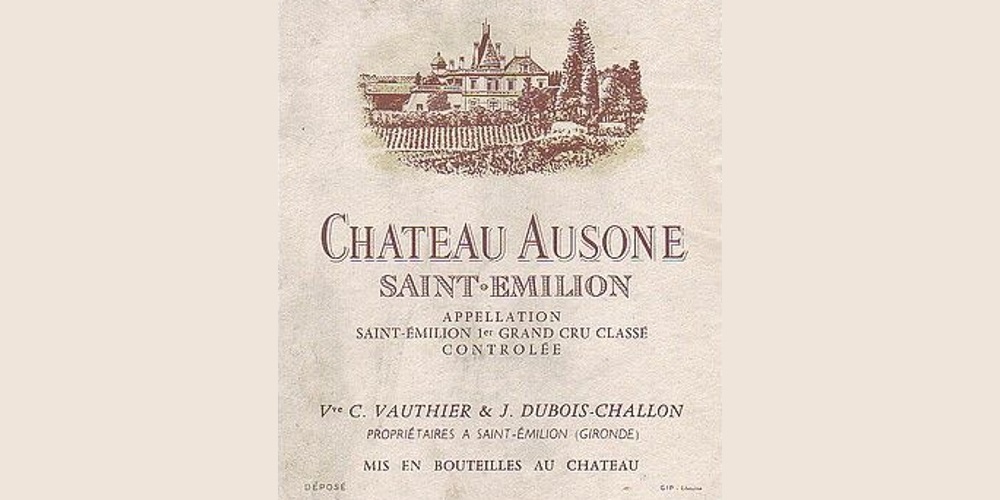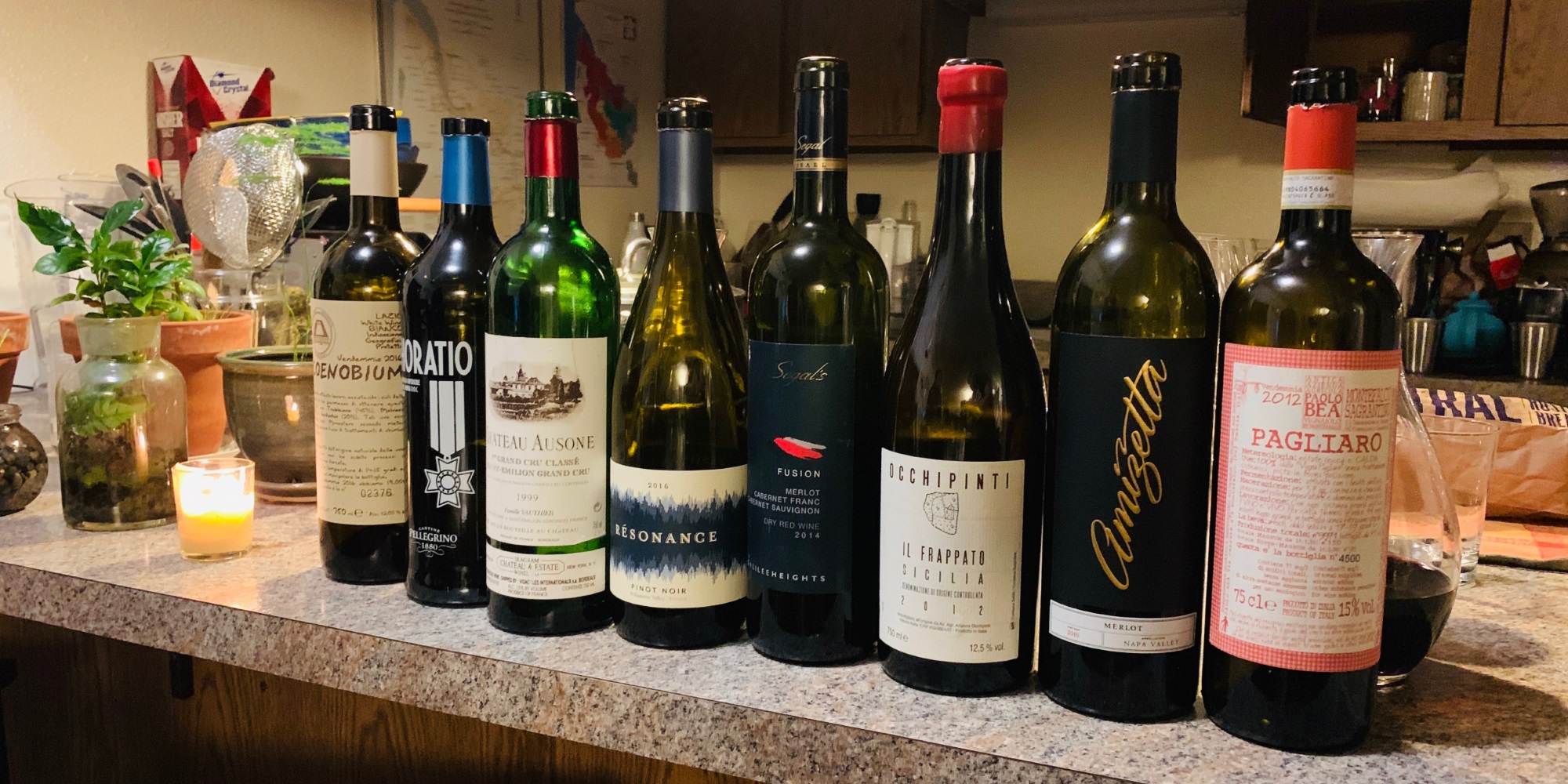Château Ausone – Archetype Tasting
Wine Tasting, March 25th, 2019
Wine List:
- 2016 Coenobium, Lazio IGP, IT
- Pellegrino, Horatio Marsala Superiore, Ambra Secco, IT
- 1999 Château Ausone, Saint-Émilion 1er Grand Cru Classé A, Bordeaux, FR
- 2016 Résonance by Louis Jadot, Pinot Noir, Willamette Valley, OR
- 2014 Segal’s, “Fusion”, Merlot Blend, Galilee Heights, Israel
- 2012 Occhipinti, Il Frappato, Sicilia DOC, IT
- 2016 Amizetta, Merlot, Napa Valley, CA
- 2012 Paolo Bea, Montefalco Sagrantino, Umbria, IT
Attendance:
- Nick D.
- Xin F.
- Katharina P.
- Tim S.
- Rob T.
- Jonathan V.

France, a land of many classifications
The terms Premier Cru and Grand Cru are found in many of the wine regions across France. Each region has its own interpretation of these terms. Premier Cru is often abbreviated 1er Cru, and Grand Cru as GC.
Classification by Vineyard Sites:
Highlighting the fruit itself, these systems aim to showcase vineyard sites that yield exceptional wines with distinct impressions of terroir.
- Alsace
- 51 Grand Cru sites, each with a separate appellation. Rangen, Schlossberg, and Muenchberg are among the most famous. The GC vineyards were under a single appellation until 2011, when the split happened. Each Alsace GC AOP has its own rules, such as Zotzenberg which is the only one to allow Sylvaner.
- Burgundy, Chablis
- 1er Cru sites are designated, and associated with Chablis AOP. Small sites are grouped within larger 1er Cru names. For example, Butteaux is found within Montmains, and may be labelled as such.
- 7.5 Grand Cru vineyards are designated, all associated with Chablis Grand Cru AOP.
- The site La Moutonne is a monopole of Bichot’s Long-Depaquit estate, situated within Vaudésir and some of Preuses. This “unofficial” Grand Cru accounts for the 0.5 measurement above.
- Burgundy, Côte d’Or
- 1er Cru vineyard sites are designated, and connected to their respective village appellations.
- Grand Cru sites are given their own individual appellations.
- Some 1er Cru and GC sites are owned by a single estate, and are thus Monopoles.
- Burgundy, Côte Chalonnaise and Mâconnais
- Bouzeron is excluded, and the other four Chalonnaise appellations feature 1er Cru sites. The Mâconnais does not use 1er Cru.
- Beaujolais
- Ten individual communes are elevated to Cru status, and thus receive their own appellation, although 1er Cru or GC are not applicable terms.
- Loire
- All vineyards associated with Quarts de Chaume AOP may be labelled as Grand Cru, starting in 2010.
Classification by Villages:
These systems gain a more collective approach, by elevating the entire village of production. The limitations imposed by vineyard ownership are softened, thus giving smaller producers an advantage, although Mesnil GC fruit is still going to be pricey…
- Champagne
- Some entire villages are classified as 1er Cru or GC, therefore any of the vineyards associated with such villages are included. As seen with each subregion:
- Montagne de Reims: 9x GC, 26x 1er Cru
- Vallée de la Marne: 2x GC, 7x 1er Cru
- Côte des Blancs: 6x GC, 9x 1er Cru
- Single vineyards such as Clos d’Ambonnay and Clos de Goisses are not specifically classified. Instead, they are connected to their associated villages. (Ambonnay is Grand Cru, Mareuil-sur-Aÿ is 1er Cru)
- Some entire villages are classified as 1er Cru or GC, therefore any of the vineyards associated with such villages are included. As seen with each subregion:
- Loire
- Within Coteaux du Layon AOP, seven villages may append their names to appellation bottlings. The commune of Chaume may additionally label Premier Cru, by following AOP rules.
Classification by Winemaking:
The Banyuls Grand Cru appellation is unique, in that defined winemaking standards highlight the style.
- Roussillon
- Banyuls Grand Cru is distinguished from the general Banyuls AOP based on winemaking rules. Rouge is the only style allowed, thus eschewing Blanc, Ambré, and Rosé. Required Grenache percentage is higher, as is minimum aging. The vineyard area is also constrained, yet the associated communes for the AOP are the same.
Classification by Estate Ownership:
Here is where the rich kids get to have fun. Qualities of vineyard sites are less prized than the name on the label. In an era before luxury brand dominance, the top estates of Bordeaux were among the first aspirational brands. The wines made by these estates may indeed be legendary, although the folks with the biggest castles are at an advantage.
The rebellious garage-producers of Pomerol have abdicated such honors, with names such as Le Pin finding their own paths to success.
- Provence
- The wines made by these 18 estates are all considered Grand Cru, regardless of vineyard or commune name. The list was established in 1955, and was higher at 23 estates, but has since decreased. Clos Cibonne is one such estate, which is often seen in the Seattle market.
- Bordeaux, 1855 Médoc
- Estates are found in the Médoc area, and ranked from 1er through 5ème Cru. The top red wine or Grand Vin from each estate is classified.
- Bordeaux, 1855 Sauternes
- The sweet wine estates from Sauternes are ranked, with Barsac included too. The three levels are Premier Cru Supérieur, Premier Cru, and Deuxième Cru.
- Bordeaux, 1953 Graves
- Red and white wines are included in this system, for estates in the Graves area. Some estates are classified for only white or red wines, some for both colors.
- Bordeaux, 1954 St. Émilion
- Saint-Émilion Grand Cru AOP was established in 1954, and features a slightly restricted vineyard area from Saint-Émilion AOP, with a bit higher alcohol and must weight requirements. The de facto result is that most Saint-Émilion wines will be labelled Grand Cru.
- That same year, the Cru Classé system was introduced for Saint-Émilion, ranking estates into three tiers. This list of producers is revised roughly every decade, not without drama from estates who are bumped from the list.
- Bordeaux, 2002 Cru Artisan
- A system with over a hundred fifty years of history, things became official in 2002. Small estates in the Médoc area are included, 44 in total. Vineyard area must be limited to 5 hectares, and the list is reviewed every ten years.
- Bordeaux, 2018 Cru Bourgeois
- This system has gone through multiple changes and iterations, and is now active once again. Estates may apply for recognition, and the list will be reviewed every five years. The system has three tiers: Cru Bourgeois, Cru Bourgeois Exceptionnel, and Cru Bourgeois Supérieur.
– Nick Davis, April 23rd, 2019, Seattle, WA



